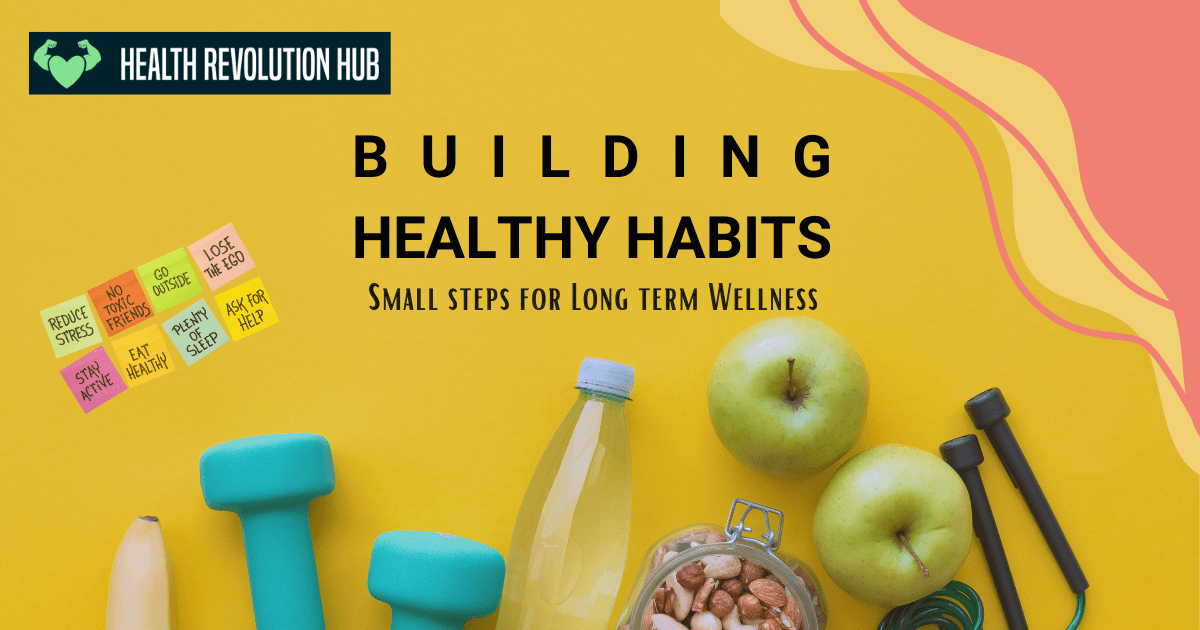Introduction:

In our fast-paced world, maintaining a healthy lifestyle can often feel overwhelming. We’re bombarded with conflicting advice and unrealistic expectations, making it challenging to know where to begin. The good news is that building healthy habits doesn’t have to be an arduous task. By taking small steps and focusing on sustainable changes, you can embark on a journey towards long-term wellness. In this article, we’ll explore practical and user-friendly strategies for developing healthy habits that will positively impact your physical and mental well-being.
Start with a Clear Vision:
Before diving into action, take some time to envision your ideal state of wellness.Having a clear vision will provide motivation and direction for building the right habits.Consider what a healthy lifestyle looks like to you. Define your goals, whether it’s improving your fitness, eating healthier, reducing stress, or enhancing your overall well-being. I’ll guide you through practical steps and strategies to help you overcome obstacles and create long-term wellness.
Steps to Start with a Clear Vision
Here are the steps you can take to start with a clear vision in building healthy habits:
Reflect on Your Values and Priorities
Take some time for introspection and reflect on your values and priorities in life. Consider what matters most to you and how your health and well-being align with those values. For example, if spending quality time with your family is important to you, you may prioritize habits that promote physical fitness and energy levels to keep up with your loved ones.
Identify Your Wellness Goals
Identify specific wellness goals that align with your values and priorities. These goals should be meaningful to you and contribute to your overall well-being. For instance, your goals may include improving cardiovascular fitness, reducing stress levels, or achieving a healthy weight. Write down these goals and be specific about what you want to achieve.
Visualize Your Ideal State of Wellness
Take some time to visualize your ideal state of wellness. Imagine how you would look, feel, and function when you have achieved your wellness goals. Create a vivid mental image of yourself living a healthy and fulfilling life. This visualization exercise helps to create a clear picture of what you are working towards.
Break Down Your Vision into Actionable Steps

Once you have a clear vision and defined goals, break down your vision into actionable steps. Start by identifying the specific habits and behaviors that will support your wellness goals. For example, if your goal is to improve cardiovascular fitness, actionable steps may include incorporating regular cardio exercises like jogging or cycling into your weekly routine.
Set Realistic Timeline
Set a realistic timeline for achieving your goals. Understand that building healthy habits takes time, and it’s important to be patient with yourself. Break your goals into smaller milestones and assign realistic timeframes to each milestone. This will help you stay motivated and track your progress along the way.
Write It Down and Review Regularly
Write down your clear vision, goals, and actionable steps in a journal or a vision board. Keep it somewhere visible and review it regularly to remind yourself of what you are working towards. This practice will help you stay focused, motivated, and committed to building healthy habits.
Seek Support and Accountability
Share your vision and goals with a supportive friend, family member, or mentor who can provide encouragement and hold you accountable. Having someone to share your progress with and seek guidance from can greatly enhance your journey towards building healthy habits.
By following these steps and starting with a clear vision, you lay a strong foundation for building healthy habits that align with your values and priorities. This clarity will guide your actions and help you stay committed to your wellness journey.
Set Achievable Goals:
Break down your larger wellness vision into smaller, achievable goals. This allows you to focus on specific areas and ensures you don’t get overwhelmed. Start with one or two goals at a time, such as adding more fruits and vegetables to your meals or incorporating regular exercise into your routine. As you achieve these smaller goals, you’ll gain confidence and momentum to tackle more significant changes.
Make Gradual Changes:

Rather than making drastic lifestyle overhauls, focus on making gradual changes. Small, consistent steps are more sustainable and easier to maintain in the long run. For instance, start by swapping sugary drinks for water or taking short walks during your breaks. Over time, these small adjustments will add up and become second nature.
Prioritize Physical Activity:
Regular physical activity is vital for maintaining overall health. Find activities you enjoy, whether it’s walking, dancing, cycling, or practicing yoga. Incorporate movement into your daily routine by taking the stairs instead of the elevator or scheduling short exercise breaks throughout the day. Remember, even a little exercise goes a long way in improving your physical and mental well-being.
Cultivate Mindful Eating Habits:

Develop a healthy relationship with food by cultivating mindful eating habits. Pay attention to your body’s hunger and fullness cues, and savor each bite. Focus on nourishing your body with whole, unprocessed foods, while allowing yourself occasional treats in moderation. Avoid restrictive diets and instead aim for a balanced approach that promotes sustainable, long-term wellness.
Prioritize Restful Sleep:
Quality sleep is essential for overall well-being. It is essential for physical and mental restoration, allowing our bodies to repair and rejuvenate. Sufficient and restful sleep supports immune function, cognitive performance, emotional well-being, and helps regulate appetite and metabolism. Prioritizing quality sleep is fundamental for optimal health and functioning in our daily lives.
Here are some tips to have restful sleep
- Establish a consistent sleep routine by going to bed and waking up at the same time each day.
- Create a relaxing bedtime routine, such as reading a book or practicing relaxation techniques, to signal to your body that it’s time to unwind.
- Minimize exposure to screens before bed and create a sleep-friendly environment by keeping your bedroom cool, dark, and quiet.
Practice Stress Management:

Stress can take a toll on our physical and mental health. You can incorporate some stress management techniques into your daily life, such as
- mindfulness meditation
- deep breathing exercises
- engaging in hobbies you enjoy.
Find healthy outlets for stress, such as regular exercise, spending time in nature, or connecting with loved ones.
Foster Supportive Relationships:
Building healthy habits is often easier when you have a support system. Surround yourself with positive, like-minded individuals who encourage and inspire you on your wellness journey. Engage in activities with friends or family that promote healthy habits, such as cooking healthy meals together or participating in physical activities as a group.
Celebrate Progress and Practice Self-Compassion:

Recognize and celebrate your progress, no matter how small. Acknowledge that building healthy habits is a journey, and setbacks are a normal part of the process.
Be kind to yourself and practice self-compassion when things don’t go as planned. Instead of dwelling on mistakes, learn from them and use them as opportunities for growth.
Conclusion:
Building healthy habits doesn’t have to be an overwhelming task. By taking small, sustainable steps, you can create long-lasting changes that positively impact your physical and mental well-being. Remember to start with a clear vision, set achievable goals, make gradual changes, prioritize physical activity and mindful eating, prioritize restful sleep, practice stress management, foster supportive relationships, and celebrate your progress along the way. Embrace the journey towards long-term wellness, and enjoy the positive transformations that come with building healthy habits.








